Does “employee engagement” sound like just another buzzword?
It might, but it actually plays a huge role in how well a company performs. When people enjoy what they do and feel connected to their work, they tend to work harder, stay longer, and help the business thrive.
On the flip side, when employees feel checked out or unmotivated, it doesn’t just affect one team or company; it adds up globally. In fact, Gallup estimates that low employee engagement at work costs the world nearly $9 trillion a year.
So, improving employee engagement in the workplace isn’t just good for morale. To help you stay in the know, we’ve rounded up the latest employee engagement stats and insights:
Guide to employee engagement statistics
Key employee engagement statistics for 2026
- Only 21% of employees globally feel engaged at work. That means nearly 8 out of 10 people around the world are just going through the motions at work.
- Low employee engagement is costing the global economy $8.9 trillion per year. This isn’t just a workplace issue; it’s a worldwide problem. Disengaged employees are less productive, more likely to leave, and often do the bare minimum. When this happens at scale, businesses lose money and potential.
- Engaged teams are 18% more productive and 23% more profitable. When people feel motivated and appreciated, they show up stronger. They solve problems faster, make fewer mistakes, and work better with their teammates.
- Turnover is 18%–43% higher in low-engagement teams. When people feel disconnected, they’re much more likely to leave. Replacing someone costs time, money, and energy, not to mention the stress it puts on the rest of the team.
- 82% of white-collar workers report burnout. Burnout has become the norm for many employees, not the exception. That’s a big red flag. Long hours, constant stress, and a lack of support wear people down, and when burnout takes hold, it’s nearly impossible to stay engaged or productive.
- Fully remote employees report 29% engagement vs. 20% for on-site. Remote work can make a real difference in how engaged people feel, likely because of the flexibility and autonomy it offers. But structure still matters. If not managed well, remote work can also lead to isolation or blurred boundaries.
- 70%–80% of engagement is tied to the employee’s manager. What is the biggest influence on how someone feels at work? Their manager. A good manager listens, supports, gives feedback, and sets clear expectations. Investing in manager training can dramatically lift engagement across the board.
What is employee engagement, and why is it important?
Employee engagement refers to the level of enthusiasm, commitment, and involvement employees have in their work and workplace.
Why does it matter so much? Numerous studies have found strong links between employee engagement and key performance metrics:
Statistics on employee engagement and productivity
Gallup looked at hundreds of organizations and found that highly engaged teams are about 18% more productive than teams with low engagement. That means a motivated team can produce almost one-fifth more than a team that’s just going through the motions.
Why the boost? Engaged employees are more likely to go the extra mile. They solve problems faster, come up with new ideas, and work better with their teammates. They also take fewer sick days, which means they’re around more consistently to get the job done.
It’s not just about speed. Quality improves, too: Gallup found that engaged teams have:
- 41% fewer mistakes or defects in their work
- 64% fewer safety incidents
- 28% less shrinkage or theft
These are big numbers that show engagement isn’t just a feel-good idea; it directly affects how well work gets done.
How does employee engagement affect company profitability?
Gallup found that business units with top-tier engagement see 23% higher profitability compared to those at the bottom. That’s a big difference (nearly a quarter more profit), and it can be what sets leading companies apart from the rest.
Why does engagement have such a big impact? A few key reasons:
- Engaged employees provide better customer service, which helps boost sales and loyalty.
- They’re more productive and efficient, which keeps costs down.
- They’re more likely to stick around, meaning lower turnover and fewer hiring costs.
On that last point, turnover in low-engagement teams is 18%–43% higher, depending on the industry. And replacing a team member isn’t cheap — recruitment, training, and lost employee productivity all add up quickly.
Zooming out, disengagement is incredibly costly on a global scale. Gallup estimates that around 9% of global GDP is lost every year due to disengaged workers who aren’t contributing at full capacity. That’s trillions of dollars in lost potential.
Employee engagement statistics worldwide
The latest research shows a concerning trend: only about 1 in 5 employees around the world feel truly engaged at work. According to Gallup’s State of the Global Workplace 2024 report, global engagement dropped to just 21%, down from 23% the year before. That may not sound like a big change, but it’s significant: Gallup points out this kind of dip has only happened twice in the last 12 years, the other time being during the COVID-19 lockdowns.
What does this mean in everyday terms? It means that nearly 80% of the global workforce doesn’t feel a strong connection to their jobs, which can seriously hurt productivity, creativity, and company growth.
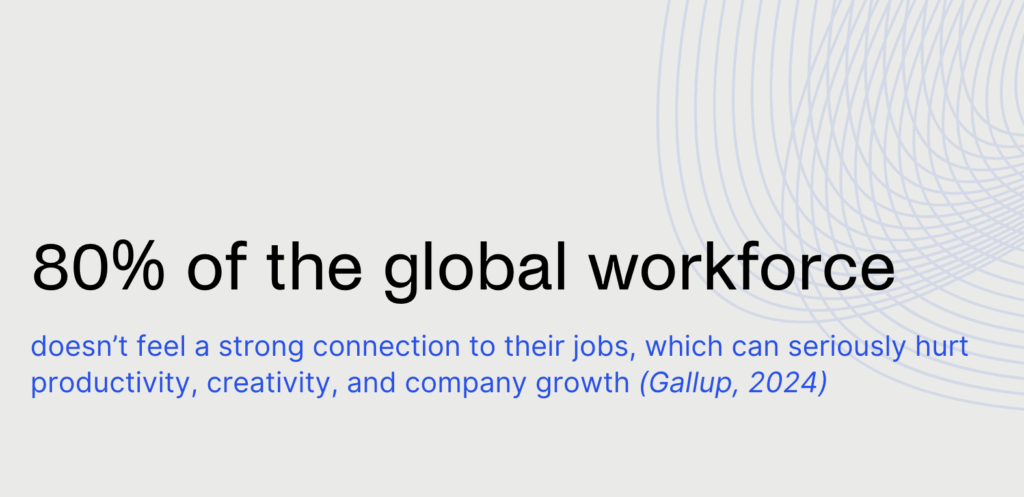
Workplace engagement statistics by country
Still, engagement levels do vary significantly by region and country. For example, in the U.S. and Canada, about 33% of employees are engaged, notably higher than the global average. Europe, however, lags with only ~13% of employees engaged, and some European countries score even lower.
France has one of the lowest engagement rates, with just 7% of workers engaged according to Gallup’s 2024 report. The U.K. is also near the bottom in Europe at only about 10% engaged, placing 33rd out of 38 European countries surveyed. In contrast, regions like South Asia have reported higher engagement (Gallup noted South Asia as among the most engaged regions, despite other challenges).
Overall, this paints a clear picture: employee engagement is struggling, even in strong economies. And with so much change happening in the world, it’s becoming harder for companies to keep their teams motivated and connected.
Employee engagement also varies by industry and role
Not all jobs or industries are the same when it comes to employee engagement. Some sectors naturally face bigger challenges than others.
According to 2024 data, industries like technology, finance, transportation, and professional services in the U.S. saw some of the biggest drops in engagement. This is surprising because these fields often offer higher pay and more workplace flexibility. But even in these high-performing sectors, stress, long hours, and unclear expectations can take a toll.
At the same time, many service and manufacturing jobs face their own long-standing challenges. These roles often involve shift work, strict schedules, and fast-paced environments, all of which can lead to burnout and lower engagement.
Globally, there’s not a full breakdown of industry-by-industry stats, but research shows that jobs with more freedom and control (like R&D or creative tech roles) tend to have higher engagement, while frontline or hourly jobs (like retail or hospitality) usually see lower engagement.
And it’s not just the type of job that matters.
Factors influencing employee engagement
Research points to several key factors that consistently influence whether employees feel engaged or not. Effective leadership and especially the role of direct managers is perhaps the most influential factor.
According to Gallup, 70% of a team’s engagement is directly linked to the manager. That means if you’ve got a supportive, motivated leader, you’re much more likely to feel the same way. And when companies get it right, the results speak for themselves. In organizations where managers are well-supported and actively involved, about 75% of managers and 70% of their teams are engaged, which is a huge improvement over the global average.
But when managers are struggling, the whole team feels it. Gallup puts it simply: “If managers are disengaged, their teams are, too”. In 2024, only 27% of managers worldwide said they felt engaged, down from 30% the year before. Some of the biggest drops were among younger and female managers, who may be facing added pressures without enough support.
There are a few other key things that can make or break employee engagement. To start with, growth and development really matter. When people feel stuck in their roles with no chance to learn or move forward, it’s easy for them to lose motivation. On the contrary, when employees are given opportunities to grow, they’re more likely to stay interested and involved.
Fair pay and work-life balance are also important. While money alone doesn’t guarantee engagement, feeling underpaid or having poor benefits can definitely push people to disengage. According to Gallup, many disengaged employees said they’d be more motivated if their company improved its culture, pay, and focus on well-being.
Having a voice at work is another big one. People are more engaged when they can share ideas and feel like their input is valued. It’s not just about being heard, it’s about knowing your opinion counts.
Other key factors include things like clear job expectations, feeling appreciated, trusting your leaders, and knowing your work has purpose. When employees see how their role fits into the bigger picture and feel supported along the way, they’re much more likely to stay engaged. But if expectations are unclear, if there’s no room to make decisions, or if the workplace feels negative or toxic, engagement can quickly fall apart.
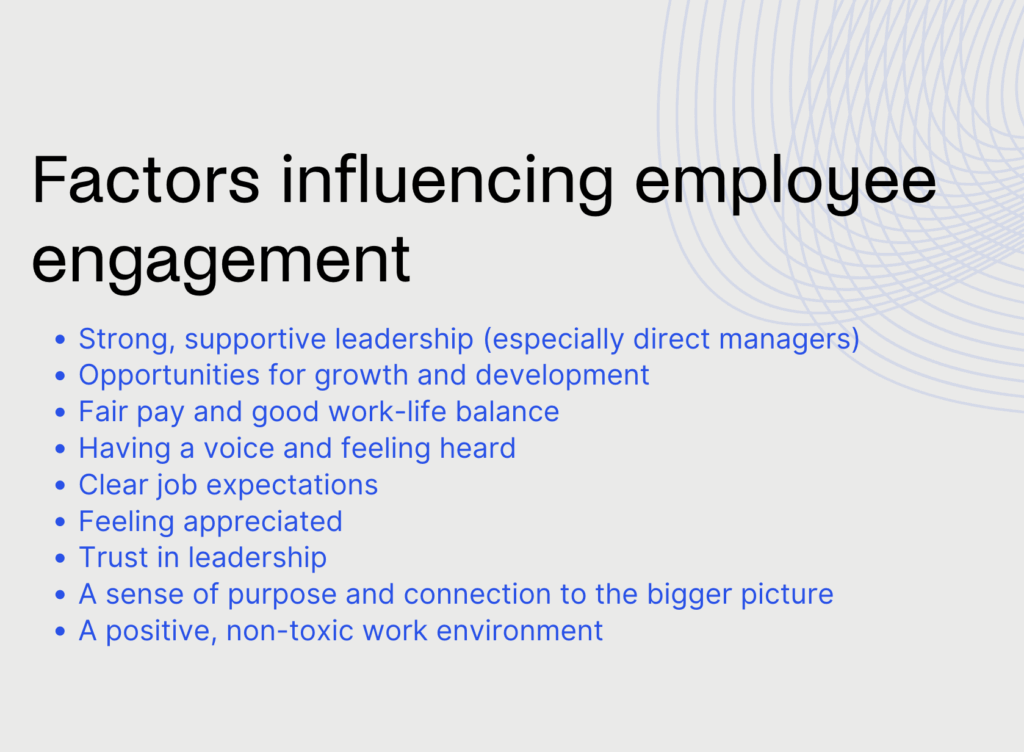
What are the signs of employee disengagement?
How can you tell if employees are disengaged? There are several common warning signs of disengagement (sometimes described as “quiet quitting”):
- Lack of enthusiasm or initiative. Disengaged employees often just go through the motions; they tend to put in time but not energy. You might notice minimal participation in meetings, reluctance to volunteer for projects, or a lack of passion in their work.
- Increased absenteeism or tardiness. Disengaged workers are more likely to call in sick or show up late because they feel less committed.
- Declining productivity or work quality is another sign. Disengaged employees often do the bare minimum required. Their output may drop, or errors and quality issues increase. Gallup’s analysis shows that business units with low engagement see significantly more quality defects and safety incidents than those with engaged employees.
- Withdrawal from co-workers or reluctance to collaborate can also signal disengagement. These employees may isolate themselves because they feel disconnected from the company’s goals or culture.
- But, perhaps one of the clearest signs of disengagement is an employee actively looking for other jobs. Disengaged individuals often have one foot out the door, since they don’t see a future with their current employer. They might openly talk about job hunting or seem indifferent about their future in the organization. Actively disengaged folks (“loud quitters”) often display negativity and may undermine what their engaged colleagues accomplish.
Stress and burnout are up, but employee engagement can help
While engagement has dipped in many workplaces, burnout and stress have gone in the opposite direction. According to a 2024 report by DHR Global, a staggering 82% of white-collar workers across North America, Europe, and Asia said they felt some level of burnout, ranging from “slightly” to “extremely” burned out. That’s a massive number.
There are many reasons behind this rising stress. Some workers point to ongoing political and global uncertainty. Others mention tight deadlines, long hours, and always being “on”, especially in remote or hybrid setups.
But here’s something important: engaged employees are much less likely to feel overwhelmed or burned out. Gallup found that about 50% of engaged workers say they’re “thriving” in life overall, while only a third of disengaged employees report the same level of well-being. In other words, when people feel good about their work, they tend to feel better in general, both on and off the job.
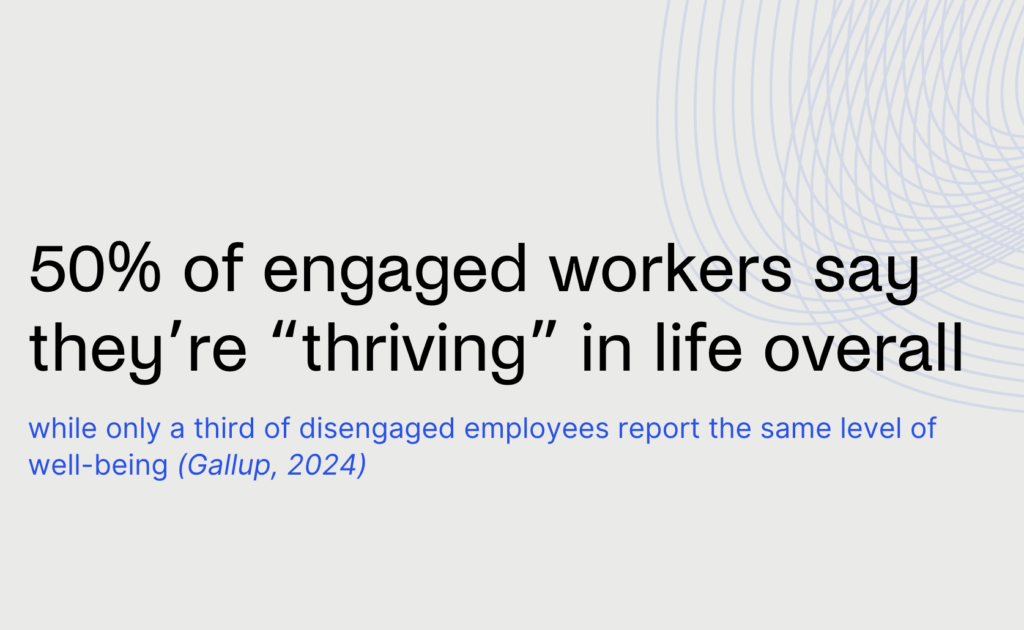
Unfortunately, global well-being seems to be slipping. Remote workers, in particular, are feeling the pressure. Which brings us to the next point:
How remote and hybrid work affect employee engagement
Interestingly, fully remote workers tend to feel more engaged than those who go into the office. According to Gallup, 31% of remote employees said they felt engaged, compared to just 23% of hybrid or on-site workers. Having more freedom and flexibility in how and where they work seems to help people feel more connected to what they’re doing.
But it’s not all sunshine and home-office vibes. Fully remote workers also report worse overall well-being. Only 36% of them say they’re “thriving” in life, compared to 42% of hybrid workers. And when it comes to stress and loneliness, the numbers tell a clear story: 45% of remote workers felt a lot of stress the day before, while it was about 39% for on-site workers. That extra freedom can sometimes come with a downside, such as feeling isolated, overwhelmed, or disconnected from teammates.
Strategies to improve employee engagement
Many of the things that influence employee engagement are totally within your company’s control:
1. Communicate clear purpose and goals
One of the most powerful (and often overlooked) ways to keep employees engaged is simply making sure they know what’s expected of them. It sounds basic, but Gallup found that only 46% of U.S. workers strongly agreed they knew what was expected of them at work back in 2020, and that number has dropped since. That means more than half of employees may be unsure about what they’re supposed to be doing or why it matters.
So what can leaders do?
- Talk openly about company goals. Not just during annual reviews or team meetings, but regularly.
- Show how each person’s work contributes to those goals. For example, explain how a customer service rep’s helpful attitude keeps clients coming back, or how a developer’s work improves the product experience.
- Involve your team in setting goals. People are more engaged when they help shape the plan instead of just following instructions.
- Celebrate progress together. Whether it’s finishing a project, hitting a milestone, or learning something new, small wins help build momentum and keep everyone motivated.
- Host regular team offsites to realign and reset. If you need help planning, Offsite makes it easy to book vetted venues and vendors and handle logistics in one place.
At the end of the day, people want to feel like their work means something. A clear purpose, consistent direction, and honest communication go a long way toward making that happen.
2. Train and support your managers
Managers have a bigger impact on employee engagement than most people realize. Gallup’s research not only shows that a huge portion of an employee’s engagement is directly influenced by their manager, but it also shows that organizations that invest in developing their managers can boost engagement by up to 28%. That’s a big jump, and it all starts with the right support.
So what does that support look like?
- Teach managers how to listen actively and check in regularly with their team members,
- Coach managers on giving feedback that’s helpful and encouraging, rather than critical or unclear.
- Help them build trust by being transparent, fair, and consistent.
- Train them to spot signs of disengagement, so they can step in early and offer help.
Also, don’t forget to recognize managers who are doing a great job. When you highlight their success and share their tips with others, you raise the bar across the whole company.
3. Prioritize mental health and well-being
Burnout is real, and it’s one of the biggest reasons employees start to disengage. When people are overwhelmed, stressed, or running on empty, it’s hard for them to stay motivated or do their best work.
Start by keeping an eye on workloads and checking in regularly with your team. Are people stretched too thin? Are deadlines piling up? Sometimes just asking, “How are you really doing?” opens the door to an honest conversation.
A few things that can help:
- Offer flexible work options when possible, like remote work or flexible hours.
- Encourage people to take their vacation days (and truly unplug).
- Create a culture that respects personal time, like setting boundaries around after-hours emails or making “no-meeting” blocks part of the norm.
- Provide access to mental health resources, such as counseling, wellness programs, or apps that support stress management. Some organizations now include online therapy in their benefits, making it easier for employees to get professional support without the barrier of in-person visits.
Even simple gestures, like reminding someone to log off at the end of the day, can show that you care.
4. Support flexible and hybrid work, thoughtfully
Most employees today value flexibility more than anything. And it’s not just an employee preference — flexibility truly helps! Gallup found that fully remote employees have higher engagement (29%) than those who are fully on-site (20%).
But here’s the catch: remote and hybrid work only boost engagement if they’re done well. Without structure and support, remote teams can start to feel disconnected or even burned out.
That’s why companies need to put systems in place that make flexible work smooth, inclusive, and collaborative, and that’s exactly where a tool like Archie can help:
- Clear schedules and visibility: Archie lets employees see who’s working from the office and when. This makes it easy to coordinate in-person days, plan meetings, or just bump into teammates, even if you’re usually remote. It helps people feel part of the team, no matter where they’re working.
- Easy desk and room booking: No more back-and-forth about where to sit. With Archie, employees can book a desk or meeting room in just a few clicks. When the office is simple to navigate, people are more likely to come in and use it.
- Interactive floor plans: Want to sit by your team, near a window, or in a quiet zone? Archie’s office floor plans let people choose where they work best — and that sense of choice boosts comfort and engagement.
- Workplace analytics: Archie also gives you insights into how the office is being used. With that data, you can adjust layouts or hybrid policies to better support what employees actually need.
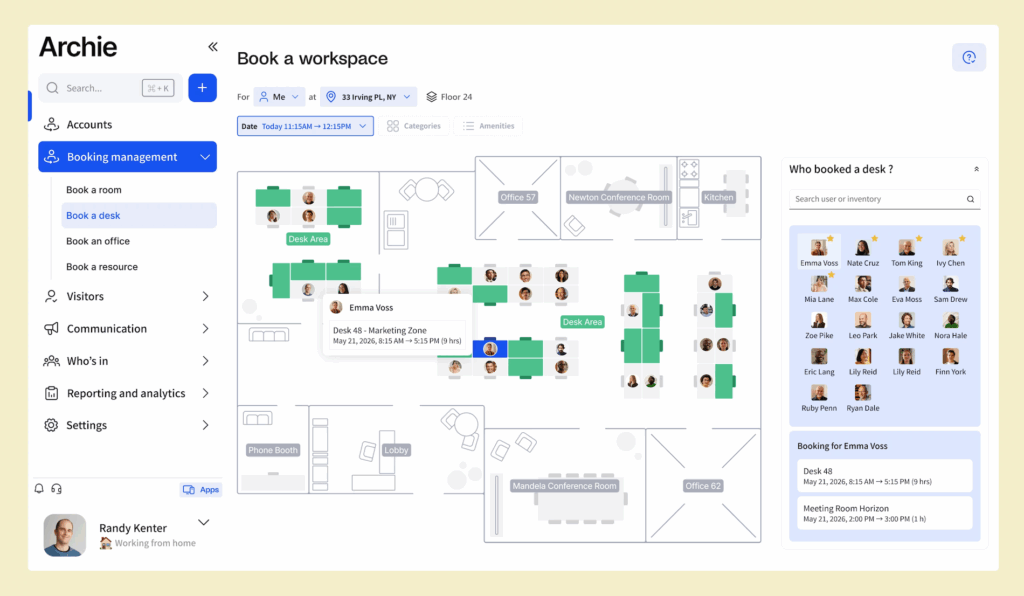
5. Listen and act on feedback
Employee engagement isn’t just about what leaders say; it’s also about how well they listen. When employees feel heard, they’re more likely to feel valued, motivated, and connected to their work.
Quick pulse surveys, casual team check-ins, anonymous suggestion boxes — make it easy for people to share what’s working and what’s not.
But here’s the key: don’t just collect feedback for the sake of it. Do something with it! Employees don’t expect perfection. But they do want to feel heard. Keep the lines of communication open, follow through on what you learn, and make feedback a regular part of how your team works. Engagement will grow naturally from there.
A summary of the most recent employee engagement stats
💡 General impact of employee engagement
- Low employee engagement costs the global economy nearly $9 trillion annually, or about 9% of global GDP.
- 70% of a team’s engagement is tied to their direct manager.
- In well-managed teams, 75% of managers and 70% of employees report being engaged, much higher than the global average.
- Organizations that invested in manager development saw up to a 28% improvement in engagement.
📈 Employee engagement and productivity
- Teams in the top 25% for engagement are 18% more productive than teams in the bottom 25%.
- Highly engaged teams have:
- 41% fewer defects in their work
- 64% fewer safety incidents
- 28% less theft/shrinkage
💵 Employee engagement and profitability
- Business units with high engagement see 23% higher profitability.
- Turnover is 18%–43% higher in low-engagement teams (depending on the industry).
- Engaged companies tend to recover faster during economic downturns.
🌍 Global and regional engagement rates
- Only 21% of employees worldwide feel engaged at work, down from 23% the year before.
- In the U.S. and Canada, about 33% of employees are engaged.
- In Europe, average engagement is just 13%, with France at 7% and the U.K. at 10%.
- South Asia is one of the most engaged regions globally.
- In 2024, only 27% of managers globally reported feeling engaged, down from 30%.
🧠 Burnout, well-being & mental health
- 82% of white-collar workers across North America, Europe, and Asia said they felt some level of burnout.
- 50% of engaged employees say they’re “thriving” in life vs. 33% of disengaged employees.
- Global well-being dropped slightly from 35% to 34% “thriving” in 2023.
- 20% of all workers feel daily loneliness; remote workers are the most affected.
- Companies that prioritize mental health see 13% higher productivity, with lower stress and fewer sick days.
🏡 Engagement and remote/hybrid work
- Fully remote workers report 31% engagement, compared to 23% for hybrid or on-site workers.
Only 36% of fully remote workers say they’re “thriving,” compared to 42% of hybrid workers. - 45% of remote workers said they felt a lot of stress the previous day, vs. ~39% of on-site workers.
- Nearly 40% of employees want more remote flexibility.
🗣️ Employee voice, growth, and recognition
- Only 46% of U.S. workers strongly agreed they knew what was expected of them in 2020, and the number has since declined.
- Only 3 in 10 employees say they received recognition in the past week.
- 69% of employees say they would work harder if they felt more appreciated.
- 58% of employees wish their employer asked for feedback more regularly.
- 70% of employees say their sense of purpose is defined by their work.
Sources

Berenika Teter
Archie's Content Manager, fueled by filter coffee and a love for remote work. When she’s not writing about coworking spaces and hybrid workplaces, you can probably find her exploring one.
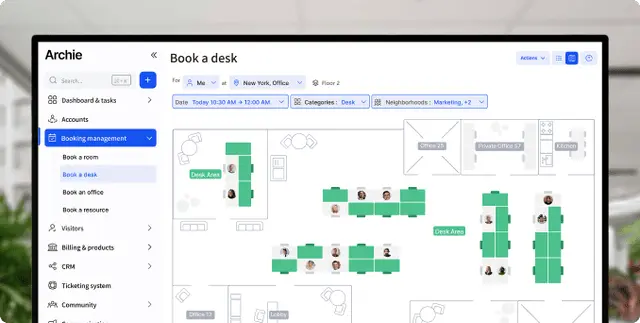




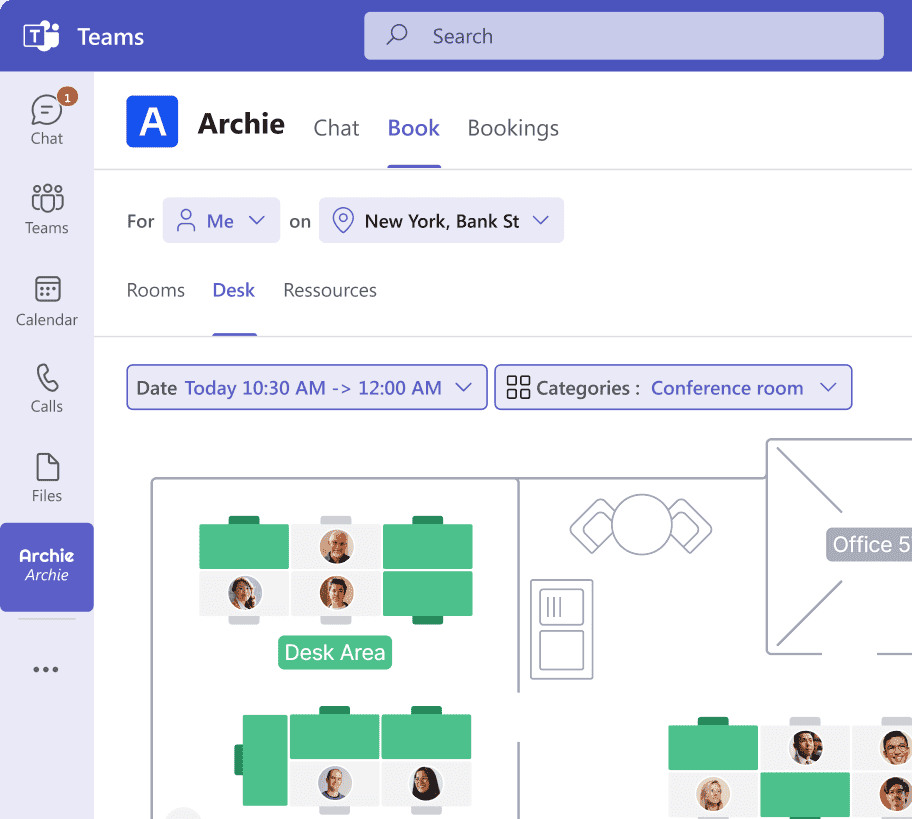
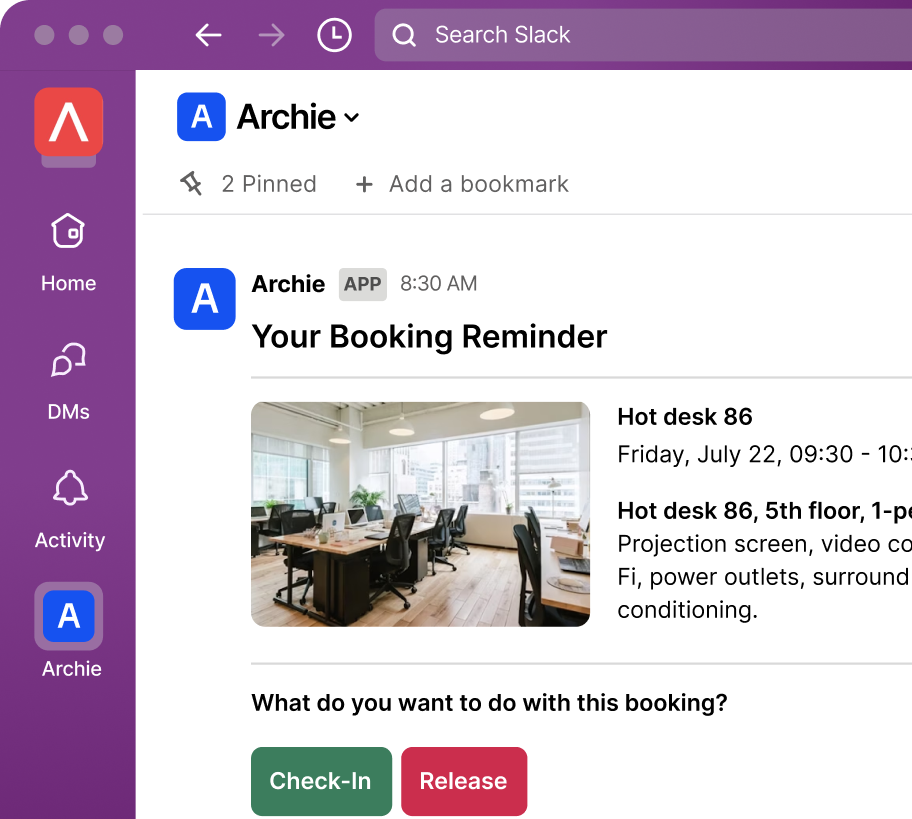
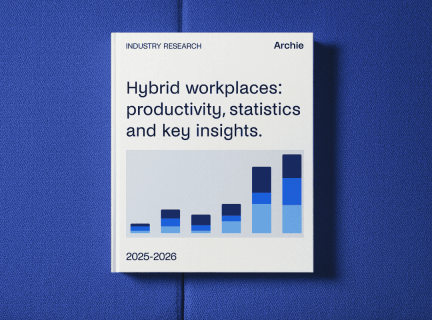

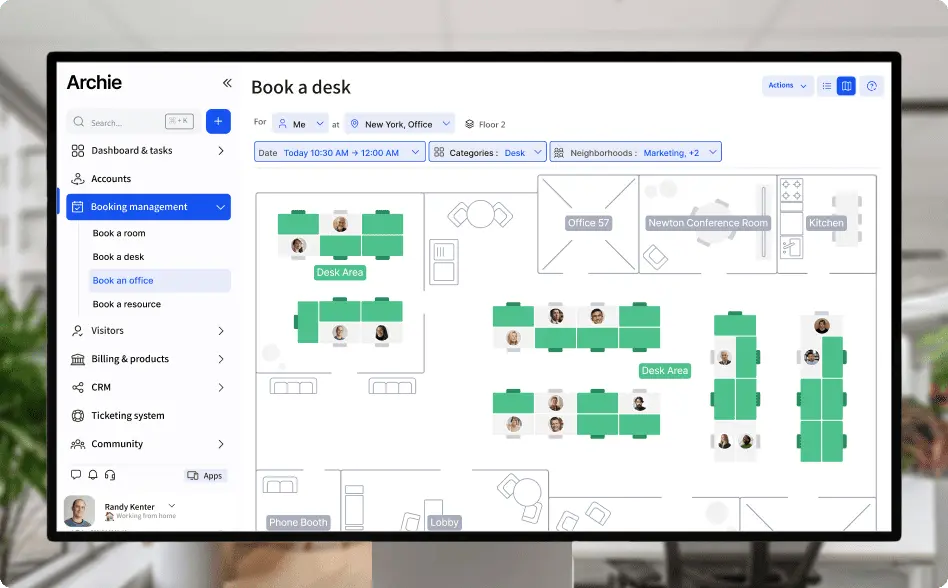
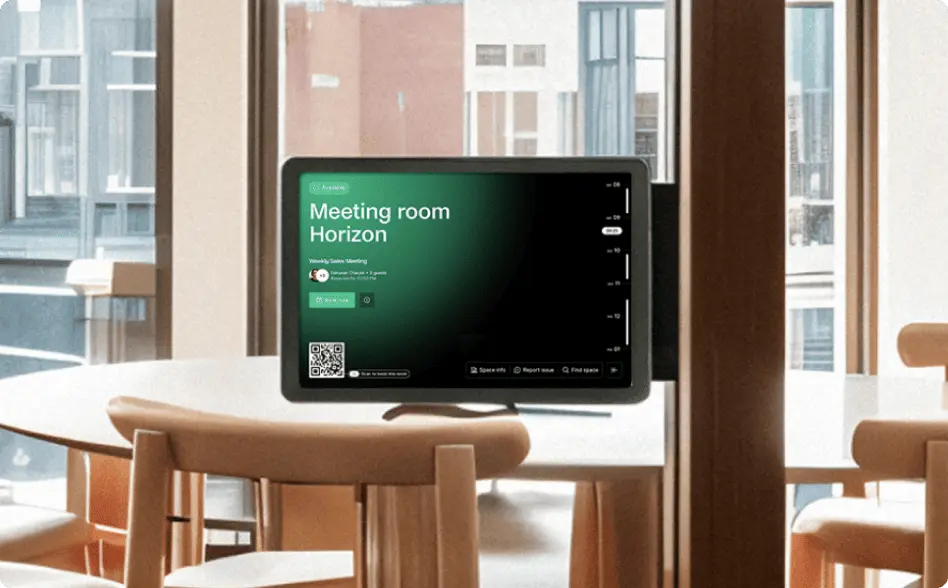




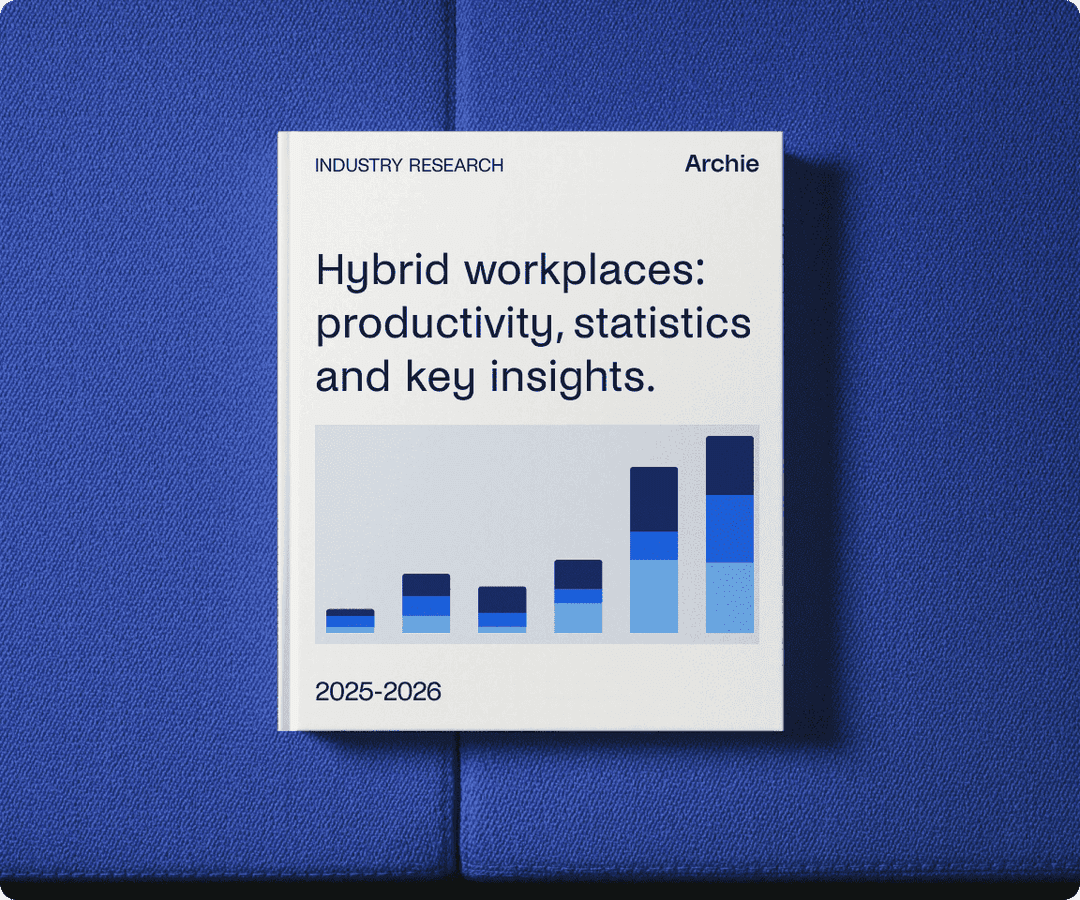


![The Latest Coworking Statistics & Industry Trends [2026] A cozy coworking space with wooden walls, warm lighting, and a large map of South America.](https://archieapp.co/blog/wp-content/uploads/2025/08/Latest-coworking-statistics-cover-image-400x400.jpg)
![RTO: Return-To-Office Statistics, Research & Trends [2026] Modern meeting room with large windows, a wooden conference table, pink chairs, and industrial-style ceiling lighting.](https://archieapp.co/blog/wp-content/uploads/2025/04/RTO-statistics-cover-image-400x400.png)

